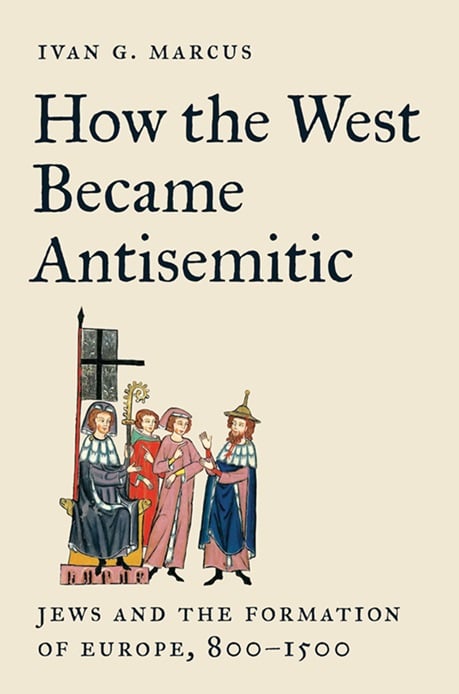Book Review: How the West Became Antisemitic
Ivan G. Marcus’s new book, How the West Became Antisemitic: Jews and the Formation of Europe, 800-1500, offers some insight into how medieval anti-Judaism evolved into modern-day antisemitism.

I’m a bit late to getting reviews online of my Tishrei reading but Ivan G. Marcus’s new book, How the West Became Antisemitic: Jews and the Formation of Europe, 800-1500, offers some insight into how medieval anti-Judaism evolved into modern-day antisemitism. At a time when anti-Jewish hate is the worst it has been in decades, this book could not be more important than it is right now.
The book immediately piqued my interest as I was perusing the Princeton Press website and saw it listed as a related title for a different book. I’m not sure exactly when I started reading it as I didn’t really get much of any reading done while in LA in early November. In any event, I did a good amount of reading over two Shabbos during the next two weeks, finishing on the Shabbos afternoon before Thanksgiving.
When we look back at the medieval history of Europe, people have this idea of thinking that Jews were passive victims. Marcus’s book shows otherwise, saying that Jews were assertive and were able to form a civilization in Western Europe. But as we all know, all good things must come to an end. The lessons of the past have never left us—we have this idea of knowing that the vibes are off and we need to pack up our bags once again. I fear that this moment may be coming soon in the US. But anyway, during the expulsions from Western Europe, the Jews of Western Europe either died, were forced to convert to Christianity, or they managed to find safety elsewhere. Mind you, this was during an era when both Jews and Christians said they were the chosen people. Even when Jews lent money to Christians or Christians offered safety to Jews, one was anti-Christianity while the other was anti-Judaism.
Marcus explores the ways in which medieval Jews insulted Christianity. Meanwhile, both religions would resort to the concept of Latrine Blasphemy, a concept that I had never heard of before. However, I was also raised with knowing that we’re not supposed to think about the Torah in the bathroom. It’s the reason why we must wait until we’re outside the bathroom before reciting the bracha for washing our hands. Another chapter explores eucharistic fantasies—saints, imagined killers, and Jewish saints. Marcus also looks at the cultural aesthetics of it all: sexual threats, conversions, and the imagined Jews. The penultimate chapter deals with expulsions, imagined Jews, and real Christian antisemites. Last but not least, we see how the medieval anti-Judaism evolved into antisemitism.
Everything changed during the First Crusade. The First Crusade started out as what was supposed to be a battle against the Muslim Caliphates for the control of Jerusalem. What ended up happening was that the Christian Crusaders decided to take it out on the “enemies” at home, the Jews, before making their way to Jerusalem. Things would only get worse for the Jews throughout the following Crusades.
Everyone knows by now that the first Christians were former Jews. However, Jews viewed Christians as being misguided practitioners of ancestral Jewish customs. However, the Jews of this era viewed Christianity as being idolatry. To this day, Jews are prohibited from walking into a church as written in the Talmud (Avodah Zara 17a). How did Christians feel? They despised Jews, both real and imagined. They looked at Jews as being subordinate but also an “enemy within.” Even when Jews were forced into converting, they were still viewed as Jews because of the physical traits—what was first anti-Jewish hate due to religious beliefs would eventually evolve into anti-Jewish hate because of ethnicity and race. We were otherized and ostracized as a people then, no different than what’s happened during the modern day.
When one examines modern antisemitism, the bigots view Jews as being powerful or controlling the world, amongst other things and it all goes back to the anti-Judaism of the medieval era. The form of anti-Jewish hate may have changed but it remains a 2,000+ year old virus that hasn’t gone away. It probably won’t ever go away but the burden should not have to be on the Jewish community for calling out the hatred on either side of the aisle. It’s important that allies learn what anti-Jewish hatred is and the forms in which it comes. Make no mistake that it is not just limited to the right-wing—the hatred is pretty terrible on the left and has been since October 7.
At a time when anti-Jewish hate is at its worst levels in decades, Ivan G. Marcus’s book, How the West Became Antisemitic: Jews and the Formation of Europe, 800-1500, feels both timely and relevant. People would be doing themselves a huge favor by reading the book. It might not defeat antisemitism but maybe people will learn to look for the signs and help fight back against hate.